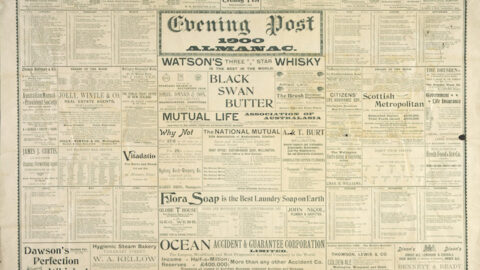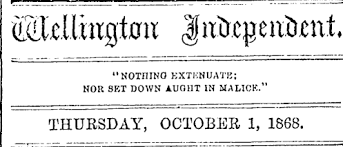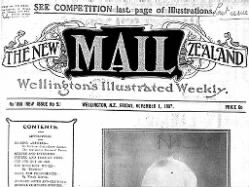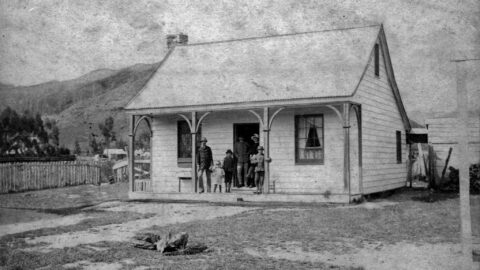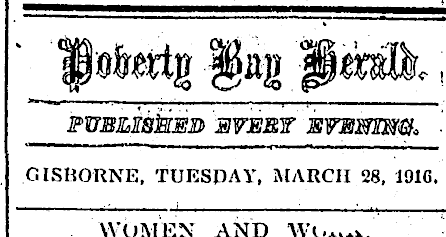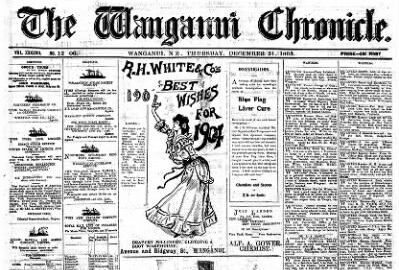Visit to the Wainui-o-mata Waterworks
The completion, after nearly three years of continuous labor, of what is known as the “Long Tunnel” in connection with the Wainui-o-mata waterworks, was celebrated yesterday with considerable festivity. Mr. W. F. Oakes, the contractor for these enormous works, had invited the members of the City Council and the officers of the Corporation to visit the site and inspect a portion of the works. Advantage was taken of the presence of the Japanese man-of-war ‘Riujio’ in these waters to extend the invitation to the officers of that vessel.
Accordingly, at half-past 9 o’clock yesterday morning, the City Councillors, together with a number of their friends and representatives of the Press, assembled, pursuant to appointment, opposite the City Council Chambers. They were driven out to Lower Hutt, with two four-in-hand buses and five wagons being called into requisition for that purpose. The Japanese naval officers, of whom thirteen accepted the invitation to join the party, were conveyed as far as the Lower Hutt station by rail about an hour later, accompanied by the Mayor. At Lower Hutt, the train was met by the cavalcade of vehicles containing the “City Fathers” and other visitors, and the naval guests were transferred into one of the large buses. Without unnecessary delay, the journey resumed, and the procession wended its way toward the site of the “Long Tunnel” via McNab’s gardens.
Here, a halt was made, and the party, numbering about 80 gentlemen, trooped into the gardens, over which they were shown by the proprietor. He displayed utmost care in pointing out the many beauties which, even at this season of the year, could be seen within the garden’s boundaries. Nearly half an hour was spent exploring the gardens, and the officers of the ‘Riujio’ expressed delight at the numerous specimens of Japanese plants and flowers to which their attention was directed.
The party then proceeded to the site of the wooden bridge spanning the Hutt River, intended to carry the large water mains for the water service. After this stop, the group moved toward the “Long Tunnel,” which had been described in detail in recent reports. The tunnel, nearly half a mile long, was designed to carry pipes through the hill separating the Wainui-o-mata Valley from Wellington Harbour. It is pierced through the hill at a considerable altitude from the road level, and its mouth is accessed via a wire tram, powered by machinery placed at the terminus above. One track ascends from the bottom of the hill, while another descends from the top, crossing at a siding at the halfway point.
Before the journey up this steep incline began, a case of champagne was opened, and most of the visitors enjoyed the beverage after their hot, dusty ride from the city. As the trucks started moving, the Mayor, along with as many naval officers as could crowd into the first truck, were conveyed upward, their ascent anxiously watched by those below due to concerns about the wire-rope’s capacity. However, Mr. Oakes assured the group that the rope could bear a strain of at least five tons. Some members of the party, not reassured, preferred to climb the hill on “all fours” rather than risk the tram ride.
No accidents occurred until the last trip but one, where eight or nine gentlemen—many of considerable weight—filled a truck. As the truck ascended the steep track, it nearly stood on end, and two men slipped out at the back in an ungraceful manner. One was dragged for several yards up the hill, with one leg jammed in the truck and the other scraping against the side, spilling silver coins along the way. He eventually freed his leg and continued the journey on foot.
Upon reaching the tunnel’s mouth, the visitors entered single file and traversed it from end to end. The experience was not pleasant. The tunnel was ankle-deep in water in many parts, and the dim candlelight did little to illuminate the way. As a result, many emerged wet from their attempts to “pick their way” around the puddles, often landing in the deepest parts instead. After completing the tunnel, a detour was made over the hill to its other mouth, where a hut decorated with ferns, palms, and flowers had been prepared to host a splendid meal.
The word “Welcome,” made of evergreens, caught the visitors’ attention at one end of the room. With the hut only accommodating about 40 or 50 people, the meal was served in two relays. Mr. George Fisher chaired the first relay, accompanied by Captain Ito and the officers of the ‘Riujio.’ Numerous toasts were honored, including one to Captain Ito and his officers, which was responded to in a speech by Captain Ito, interpreted into English, and concluded with three hearty cheers for the Mayor and Corporation.
The Mayor then proposed the health of the contractor, Mr. Oakes, who appropriately acknowledged the compliment. Dr. Diver proposed “The City Engineer,” to which Mr. J. D. Baird responded. At the second relay, Councillor Greenfield chaired the gathering, with further toasts being made, including to the Mayor, the City Engineer, the workers on the project, and the corporation officials. Mr. Quick acknowledged the toast to the guests, and the event concluded with further rounds of cheers and well-wishing.
Tags: Newspaper Oakes Pipeline Tramways Tunnels Waterworks
